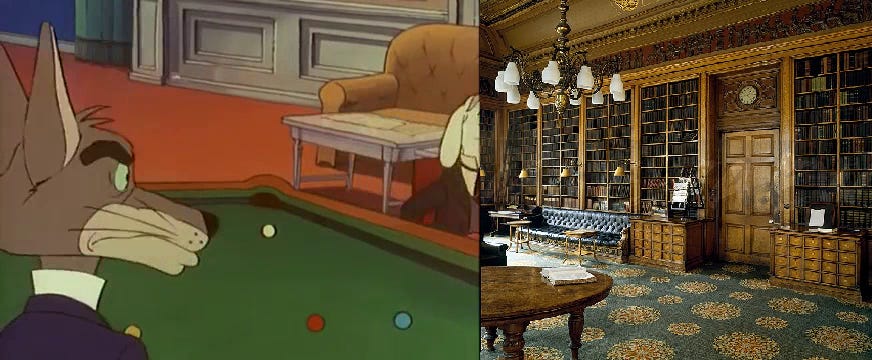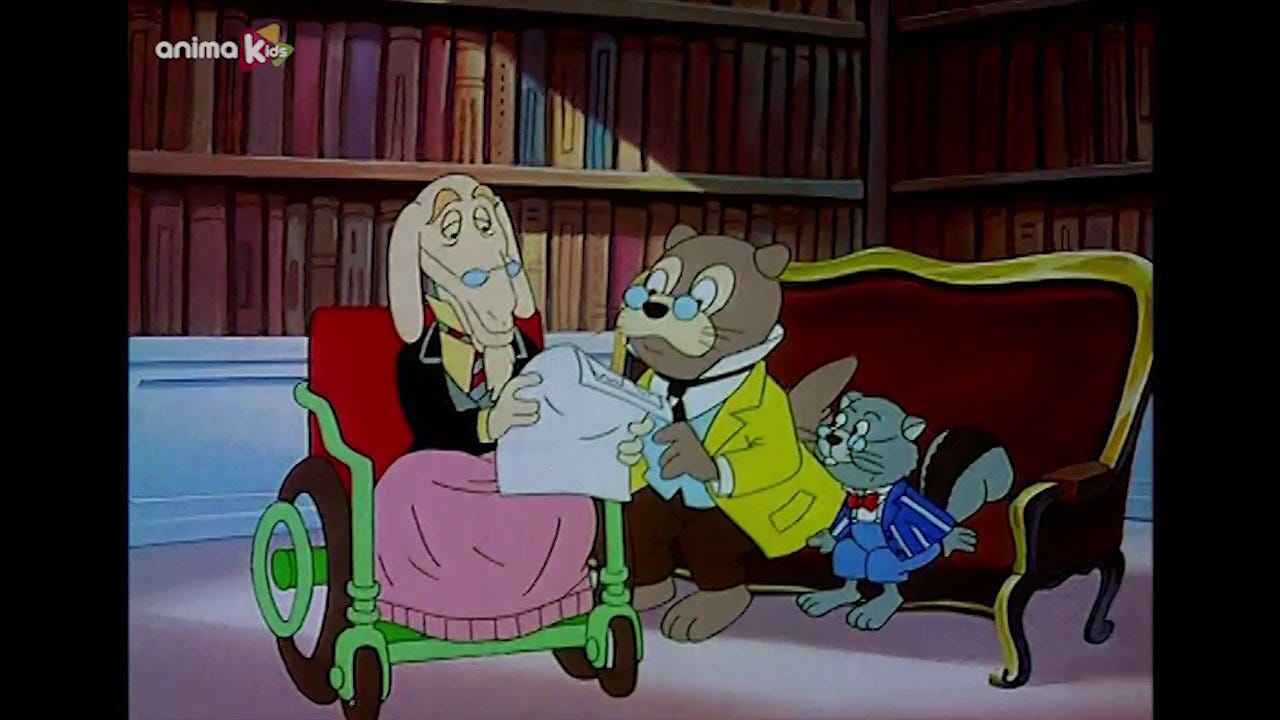This is Around the World in 80 Days week. That’s right, with its depiction of the Reform Club being so iconic, I’m going to do a separate post for 6 days this week, each one looking at a different version of Around the World in 80 Days, and how it depicts the Reform Club.
Today, I’m looking at the cartoons - the excellent 1984 Willy Fog adaptation, as well as two, er, lesser versions from 1972 and 1994-5.
The 1972 cartoon
I shan’t waste many words on the 1972 16-part American cartoon series Around the World in 80 Days. It’s absolutely terrible. (So terrible that it doesn’t even have an ending.)
I shall simply limit myself to saying that the Reform Club is only glimpsed in the opening titles, and bears no resemblance whatsoever to the real-life building, instead being modelled on a medieval castle, complete with suits of armour.
The 1984 cartoon
The fondly-remembered 1984 26-part Spanish cartoon serial Around the World with Willy Fog is another matter altogether. And I don’t just say that because I have cherished childhood memories of watching it as a four-year-old, while travelling around the world.
Despite the cartoon being populated with anthropomorphic cats (for the protagonists) and dogs (for the antagonists), it is actually one of the most accurate and diligently-researched depictions of the Reform Club onscreen. The animators clearly based their portrayal of the Club on extensive photographs, both inside and out.
It is not perfect: the exterior was clearly based on a modern photograph, rather than the Reform Club in the Victorian era. This is obvious from the neighbouring building to the right. I have previously written about how the former Carlton Club site bombed in World War II is now occupied by Rudolph Palumbo’s neo-classical 1950s office block, with its distinctive twin towers. Around the World with Willy Fog gives us a ‘Victorianified’ version of this 20th century office building, rather than an emulation of the Victorian-era Carlton Club that would have stood on the site next door to the Reform Club. Nevertheless, it obviously takes its visual inspiration from the real Pall Mall, rather than simply being an imagined design. And the Reform Club itself has a faithfully-recreated exterior, with abundant accurate details.
The interiors of the main club rooms are also fairly accurate. They are characterised by friezes running high along each wall: an actual feature of the Reform Club building by Charles Barry (with the real-life friezes made of papier-mâché.) Similarly, the design of the bookcases mirrors the real thing. It is an impressive level of attention to detail, especially in a children’s cartoon.
The depiction of the Club’s billiards table is a little more embellished. There is a Billiard Room in the Reform Club, although it is not an original feature; it is a reclaimed and converted space behind the stairs, without the fireplace depicted in the cartoon, and its (much smaller, frosted) windows overlook a brick wall on the side of the Travellers Club. But it is quite capacious, with a viewing gallery framed by columns.
The one seen in Around the World with Willy Fog is lighter and airier, clearly set in one of the main club rooms; although it is quite possible that billiards tables moved rooms over the years.
Yet such small embellishments should not detract from just how accurately the Reform Club was rendered throughout so much of its original Willy Fog appearance. There are touches like the clustering of twin pillars together - a configuration seen throughout the club. Similarly, the Reform Clubs mantelpieces were not too removed from the cartoon version.
Even the design of the chandeliers is a good match for those found in the Reform Club, then and now. The cartoon was overflowing with loving detail.
Even the dimensions of the window panes remains a good match for the real thing. The Willy Fog cartoonists understood the importance of world-building, and did their research when it came to replicating the Reform Club's interior and exterior.
So yes, it was a children’s cartoon with all the characters as cats and dogs. Yet it was also a beautifully rendered recreation of the Reform Club, with only some light embellishments around colour shades and furnishing. (The sofa in the smoking room may have been a bit out of place - but not too much.)
The 1994-5 cartoon
Around the World with Willy Fog was such a runaway international success, that a sequel followed a decade later. Willy Fog 2 was a 26-part adaptation of two other Jules Verne novels, Journey to the Center of the Earth and 20,000 Leagues Under the Sea, rewritten to insert the same protagonists as Around the World with Willy Fog.
Unfortunately, it was much more cheaply-done than the original, with far cruder animation. And the loving research of the original was not to be found. They clearly referred back to past episodes of the previous series; so the animation of the sequel feels like a third-generation photocopy. Here, the Reform Club exterior is copied, but the dimensions are all wrong, having been compressed, the window panes being wrong and the ballustrades simplified. The contrast makes you realise the success of the original.
It was adequate when simply mirroring the Reform Club settings seen in the first series; although the dimensions seem to have been distorted - what was a small room in the first series has been stretched to a huge one here. Neither interior nor exterior windows match the real window dimensions.
And as mentioned, the armchairs were the one thing that looked “off” in the original. In the sequel, this is even more so - they look more 1950s than 1850s.
The above illustrates my point about dimensions. The architectural details - copied from the first cartoon’s rendition - are not wrong. But the proportions are all over the place, exemplified by the pillars: nowhere in the Reform Club building are they squashed in this way.
The Reform Club has inset bookcases built into the walls. (Some of them were belatedly added, such as in the main library, where they were inserted in the 1850s.) Nowhere do bookcases jut out from the wall like this.
Where they most obviously run into trouble is in attempting new Reform Club interiors, not based on anything seen in the previous serial. The scene above-left looks more like a living room, with generic ‘fancy’ wingback armchairs inserted, rather than resembling anything in the Reform Club. And while those armchairs broadly fit the stereotype of what a luxurious London club’s chairs look like, they are closer to those found in the Georgian-era clubs, and do not resemble the furniture in the Reform Club at all.
Some of the furniture depicted is more Louis XIV than Reform Club.
Don’t get me wrong, I remain enormously fond of Willy Fog 2, and I have happy childhood memories of watching it on Sunday mornings. But the animation quality was a huge step down from Around the World with Willy Fog, and it lacked the impressive research of the first serial.
(This piece was adapted from an old Twitter thread I wrote on the topic three years ago. This is Part 3 of my 6-part look at six different versions of ‘Around the World in 80 Days’; previous articles have looked at Jules Verne’s original novel; and at the 1956 film adaptation.)
You can view the full and varied backlog of Clubland Substack articles, by clicking on the index below.
Index
Articles are centred around several distinct strands, so the below contains links to the main pieces, sorted by theme.





















I find your attention to detail in analysing these cartoons hilarious - but wonderful!